Are High Schools Preparing Students for the Future?
High school is the last stop before students enter the real world of college, career, and adult life. It’s where adolescents are supposed to develop both academically and socially, so they’ll graduate prepared for all the future has to offer. But does it?
Along with students, educators, families, and employers across the country, we at XQ believe it’s time to rethink high school to ensure that it does. We invited our readers to weigh in and here is what they told us:
Out of more than 300 participants polled, the vast majority—93 percent—said they didn’t think high schools are fully preparing students to succeed in the future.
That’s a dramatically high percentage—and it lines up with current research. A study from the Hechinger Report reveals that the vast majority of the nation’s two- and four-year colleges report enrolling students who are unprepared for college-level work. Furthermore, the National Center for Education Statistics reports that up to 65 percent of community college students take at least one remedial course.
The outlook is no better for students who go straight into the workforce, a path that has become more common following the pandemic. In one survey, a large percentage of high school graduates reported feeling unprepared for work, worried that their high school learning won’t translate to real-world challenges.
Transforming these outcomes for students means changing the high school experience. That’s why we compared the results from our audience poll with current research and perspectives from education experts to answer one big question: How can we rethink high school so all students can pursue meaningful futures?
Today’s high school students will eventually be our co-workers, as well as business owners, spiritual and community leaders, and teachers educating the next generation. By equipping learners with the knowledge, skills, and confidence to succeed in an ever-changing world, XQ believes high school can prepare all students not just to meet but shape the future. It’s a big task, which is why we encourage schools and communities to rethink high school with research-based Design Principles that can have a positive impact on how students and teachers experience school, plus Learner Outcomes that are academically rigorous and engaging. We have to get this right.
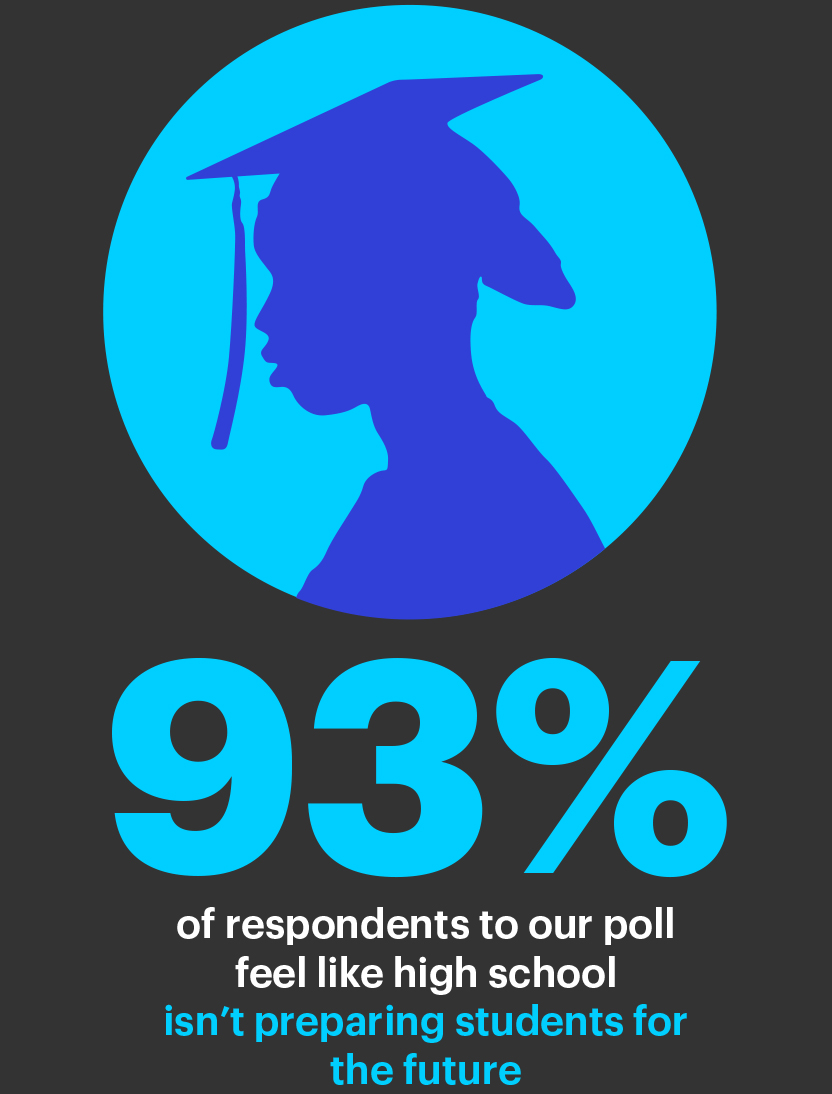

Challenges Students Will Face After Graduating High School
College Preparation
When we asked our respondents whether they think high school is preparing students for college, 60 percent of students said no. For non-students—a mix of educators, parents, and other adults—that percentage was even higher: 84 percent of them believe high schools are not preparing students for college.
The 2023 ACT test scores provided sobering data to support these views. The average ACT composite score for the class of 2023 was 19.5 out of 36. And an increasing number of high school students—43 percent—failed to meet any of the subject-area benchmarks set by the ACT, meaning they weren’t ready for college.
Researchers will study the impact on these students of interrupted education during the COVID pandemic for years to come. But prior to the pandemic, many researchers found high school students weren’t well prepared for college. A report from the Brookings Institute outlines how high schools often fail to prioritize teaching the critical thinking skills students will need in college—skills like how to analyze texts or craft persuasive arguments. Even when it comes to more traditional academic knowledge, high schools are falling short. In its report Meandering Toward Graduation: Transcript Outcomes of High School Graduates, the Education Trust shows that high school transcripts are often a poor measure of what students have actually learned. Students may pass their classes, but they lack the mastery they’ll need to tackle complex, college-level work.
Changing these patterns is crucial in order to prepare students for future success. A college degree sets students up for economic stability through the ability to pursue good, well-paying jobs. After the Great Recession in 2008, we saw how over 95 percent of jobs created during the recovery went to workers with some college education. The importance of secondary education after the pandemic will be greater than ever.
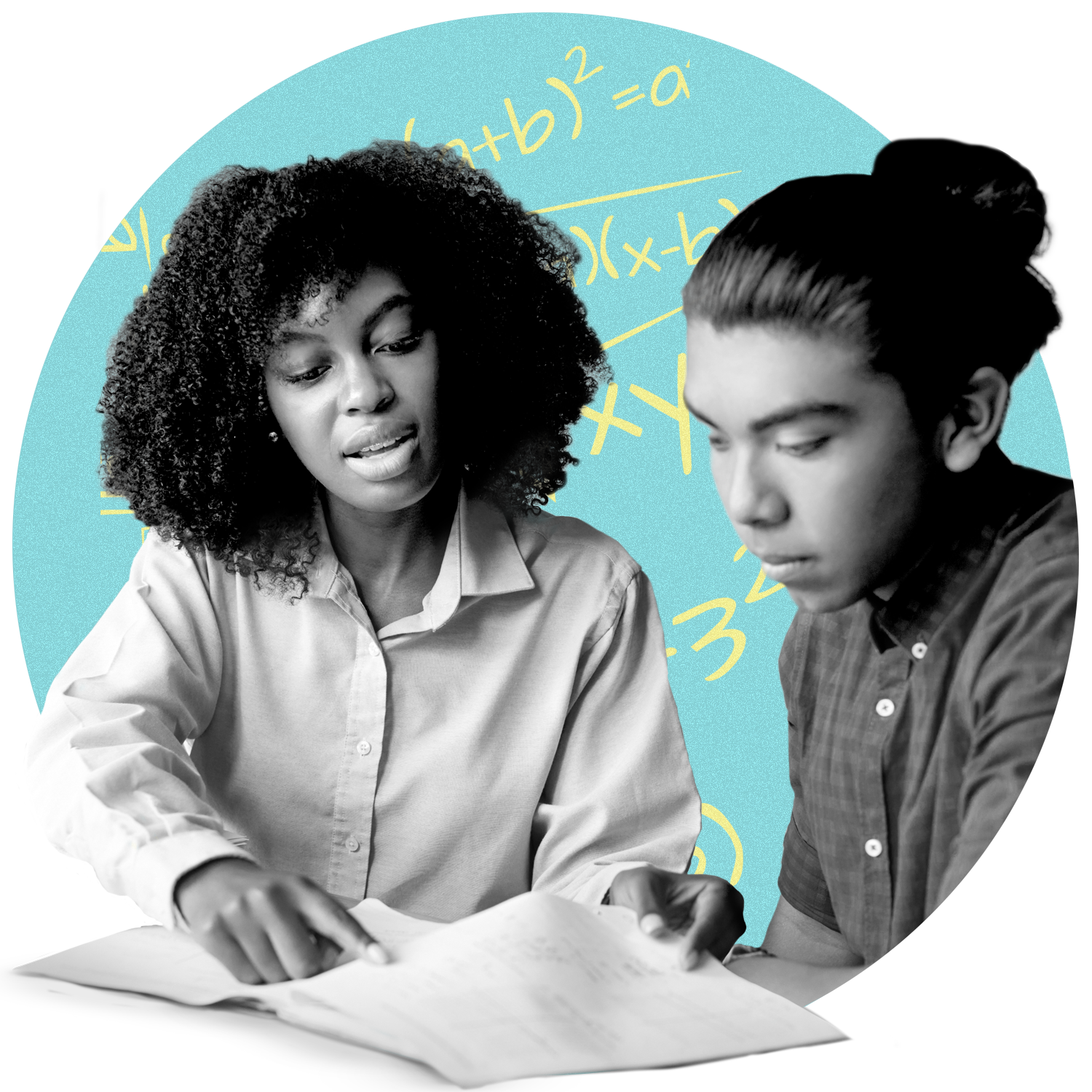

- Provide college advising resources to students throughout their high school journeys
- Create opportunities for students to take college credit-bearing classes in high school
- Prioritize mastery of content over measures like test scores and seat-time

Choosing a Career
More than two-thirds of the student participants in our audience poll believe high schools aren’t preparing students for careers. That figure is distressingly high, but it’s 93 percent for non-students, including educators, parents, and other adults.
Again, these results reflect what research shows: high school is not doing enough to prepare students for the future of work.
Today’s high school students will graduate into a workforce increasingly characterized by technology and automation. A McKinsey report on the future of work found that the COVID pandemic accelerated this shift. As a result, many more people will need to make career changes that require additional learning and skills. Yet these skills are in short supply: in a 2022 survey from Manpower Group, 75 percent of companies reported talent shortages and difficulty finding in-demand soft skills like creativity and problem-solving.
Since the pandemic, the number of high school students applying to college has decreased. Michael Hicks, director of the Center for Business and Economic Research at Ball State University’s Miller College of Business, explained to the Hechinger Report, “With the exception of wartime, the United States has never been through a period of declining educational attainment like this.” While the pandemic has exacerbated this trend, decreasing college enrollment is likely the result of a deeper shift in attitudes about higher education: fewer students and families believe the value of college is worth the time and cost. The 74 reported in early 2023 on one survey in which espondents ranked preparation for college or university near the bottom of their priorities for schools: 47th out of 57 overall.
With more high school graduates heading directly to the workforce, the need to prepare students with work-ready skills is greater than ever. A 2021 survey found 77 percent of employers believe high school preparation should focus on real world skills, rather than traditional subject matters. But most high schools are not meeting that need. Students lack enough opportunities to develop career and technical skills and gain exposure to different career paths and industries, especially in high-growth, high-wage sectors like healthcare and information technology. High schools have also failed, overall, to meet the rapidly changing nature of work, which will require adaptability and the capacity to continuously learn new skills.

To better prepare students for careers, high schools can:
- Partner with local businesses to give students early exposure to jobs and industries
- Invest in STEM and STEAM curricula
- Increase opportunities for career and technical education
- Connect students with internships to build skills and confidence
Real World
In addition to tackling college and career, high school graduates also have to navigate what it means to be an adult and community member outside of school structures.
We asked respondents on a scale of 1-5 (with 5 being “very prepared”) how prepared they thought high school students are for the real world. Only 30 percent of students rated their preparedness at a level 4 or 5. This is low, but non-students who responded were even less impressed: only 7 percent of them rated high school students’ preparedness for the real world at a level 4 or 5.
These responses echo what others have found: across the board, there’s a disconnect between what students learn in school and the skills and knowledge they’ll need to solve challenges in real life.


To better prepare students for the real-world, high schools can:
- Emphasize social and emotional learning
- Invest in caring, trusting relationships, so all students feel connected to adults
- Implement curricula and develop projects that combine academic learning with real-life skills
What does it take to be successful after high school?
Taking the challenges of college, career, and the real world into account, we wanted to know: what do students need to be successful after high school?
We asked the respondents in our audience poll to identify which skills students need for the future. “Problem-solving and critical thinking” was selected as the most important skill for success by a large margin. Separately, very few people thought that high schools teach these skills well.
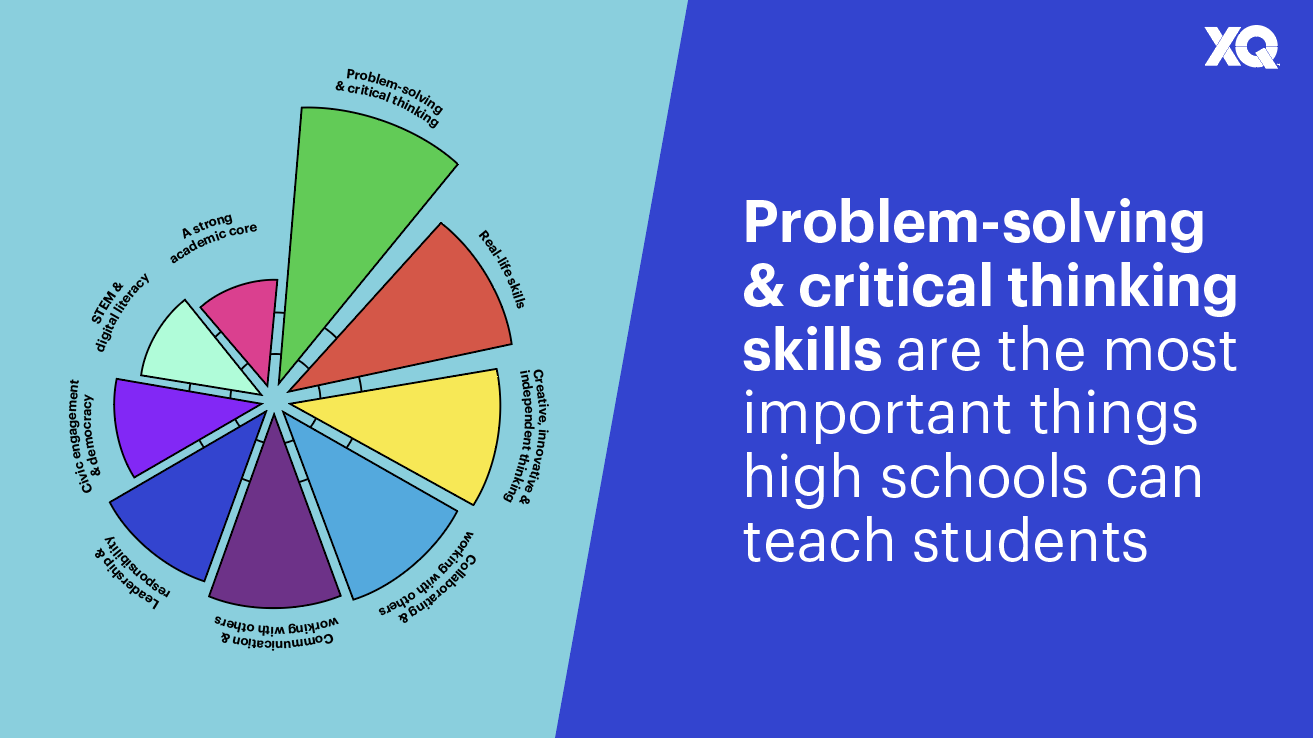
The experts we spoke to weren’t surprised that our respondents said high schools weren’t doing a good job of teaching problem-solving and critical thinking.

“We see an increased demand for these skills in the workforce and to be effective citizens in our modern world. Educators often understand the importance and value of these skills, but traditional curricula and pacing in school rarely leave room for actually focusing on them.”
– Katie Martin, author of “Learner-Centered Innovation” and “Evolving Education,” and Chief Impact Officer at Learner-Centered Collaborative.
At XQ, we recognize that for today’s learners, academic knowledge is inseparable from the problem-solving and critical thinking skills that will enable students to apply what they learn in school to real-life challenges. Our current high school structure came of age at a time when workers were needed for industrial jobs, and college was reserved for the elite.
We created the XQ Learner Outcomes to serve as a blueprint for this new kind of learning: the combined knowledge, skills, and dispositions students will need to succeed in the future. These outcomes include areas like Holders of Foundational Knowledge. We want students who don’t just possess knowledge about the world, but who can think critically to understand their own place in the world, and apply what they know to solve problems and improve their communities.
In practice, this means giving students the opportunity to apply their learning to meaningful, real-life challenges. For example, at PSI High, an XQ school in Sanford, Florida, students deepened their knowledge of their community through building micromuseums in partnership with the Sanford Museum. In this example of project-based learning, students chose lesser known aspects of Sanford’s history to focus on, and then, with feedback from teachers and community members, designed their exhibits to make an impact on viewers. They gained deep knowledge about their city, made choices about how to design their exhibits to contribute to the community, and thought critically about their own places in the city’s history. This is an example of meaningful, engaged learning—one of the XQ Design Principles.
How can we prepare students for the future?
Rethinking the high school experience with more relevant and engaging ways of learning is a community endeavor. When we asked respondents in our audience poll which actions they would take to better prepare high school students for the future, the top responses were: learning about opportunities to improve the high school experience and working directly with high school students through opportunities like clubs or mentoring.
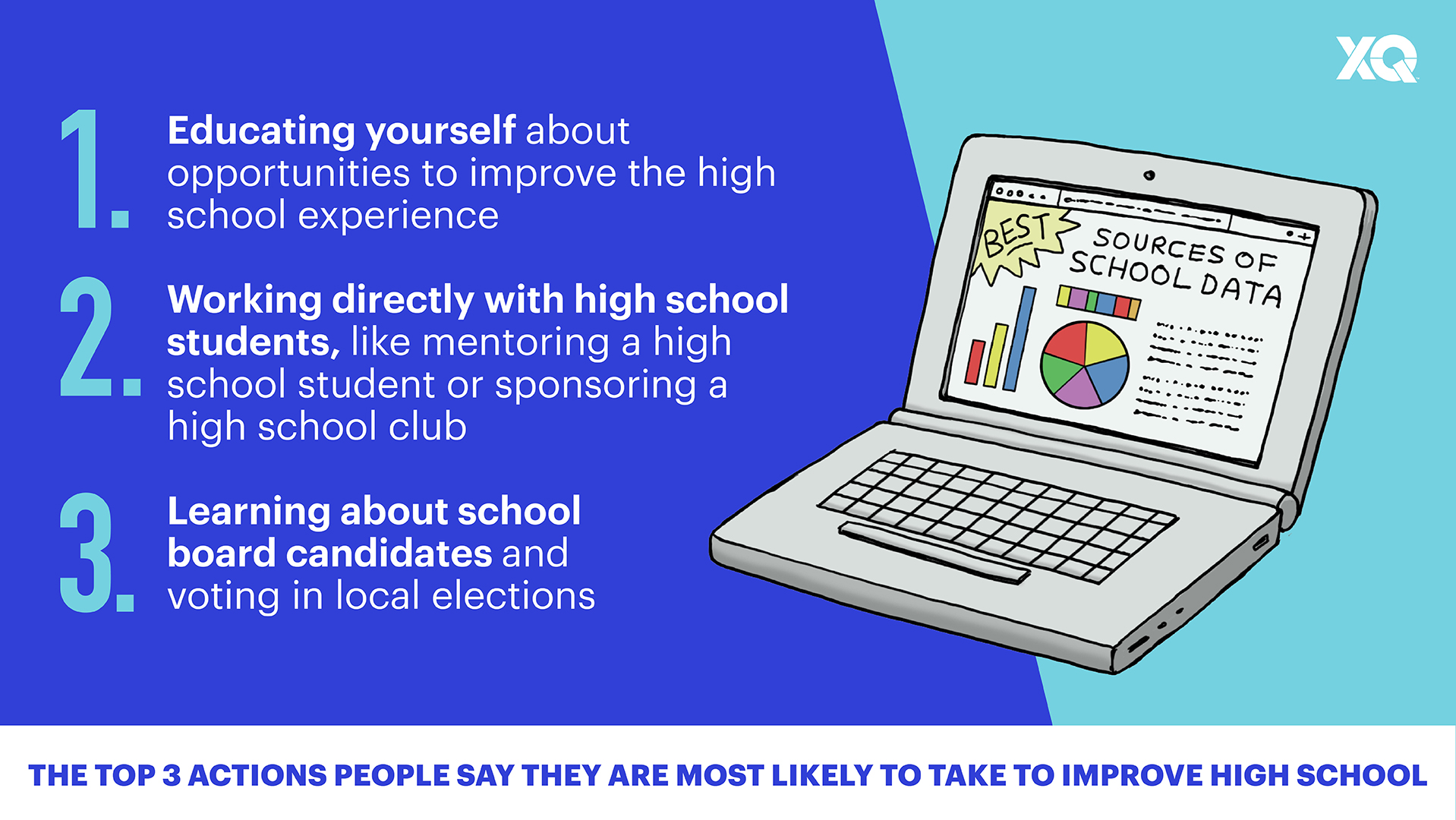
This kind of community involvement can give students valuable access to real-life perspectives. That’s the idea behind another one of our XQ Design Principles, Community Partnerships. By working alongside community members, students gain access to real-world knowledge and experiences that help them imagine and prepare for their lives post-high school.
Purdue Polytechnic High School (PPHS), an XQ school in Indianapolis, Indiana, embodies this community-centered approach. At PPHS, all students get a chance to work with local businesses and other partners on projects related to real-world challenges. For example, one group of students created a multi-step wellness plan for the school, including measures like daily wellness activities and an overhaul of the cafeteria menu. They did this by working alongside Purdue professors and students from the College of Pharmacy’s Center for Health Equity and Innovation. This partnership not only deepened the rigor of students’ work; it also exposed students to college and career pathways in healthcare and community advocacy.
These types of partnerships are successful for a reason.

-Rachel Ruffalo, director of educator engagement at the Education Trust-West.
Ruffalo cited the development of high-interest and in-demand Career Technical Education pathways through dual enrollment with community colleges. In these models, she said, “students take two or more CTE/dual-enrollment courses that culminate in a capstone course, often with an industry-recognized certificate and several earned college credits.”
For example, Sanger High School in Fresno County, California, offers students an impressive range of CTE Pathways. There are also 9-14 high schools where students can earn a high school diploma plus an industry-recognized associate degree in six years. A model called P-TECH started more than a decade ago as a collaboration between the New York City Department of Education, the City University of New York, and IBM. It now has more than 300 schools working with different companies all over the U.S. and in other countries, too, according to Rashid Davis, principal of the first Pathways in Technology Early College High School in Brooklyn.
Examples like these show why partnerships with businesses, colleges, and community organizations play a critical role in making high school feel more meaningful and engaging for students—while also setting them up better for success.
Takeaways
The consensus from our community is clear: high school is not adequately preparing students for college, career, and real life. And there’s plenty of research to support what our respondents said.
Today’s students will graduate into a rapidly changing world. Post-secondary education is increasingly important to secure good, well-paying jobs—yet too many high school students are graduating without the preparation they need to succeed in college. At the same time, as more students are choosing to go straight into jobs, high schools aren’t doing enough overall to prepare them with the skills they need for success in a workforce that’s increasingly influenced by technology and automation.
Despite these challenges, success stories from high schools across the country show that, with creativity and bold thinking, school leaders and teachers can transform these outcomes. To better prepare students for the future, schools can:
- Shift to meaningful learning experience that are project-based and interdisciplinary
- Work with community partners to give students access to real-world work environments
- Explore competency-based learning to ensure students’ mastery of content, defining competencies to include life skills like critical thinking alongside academic knowledge
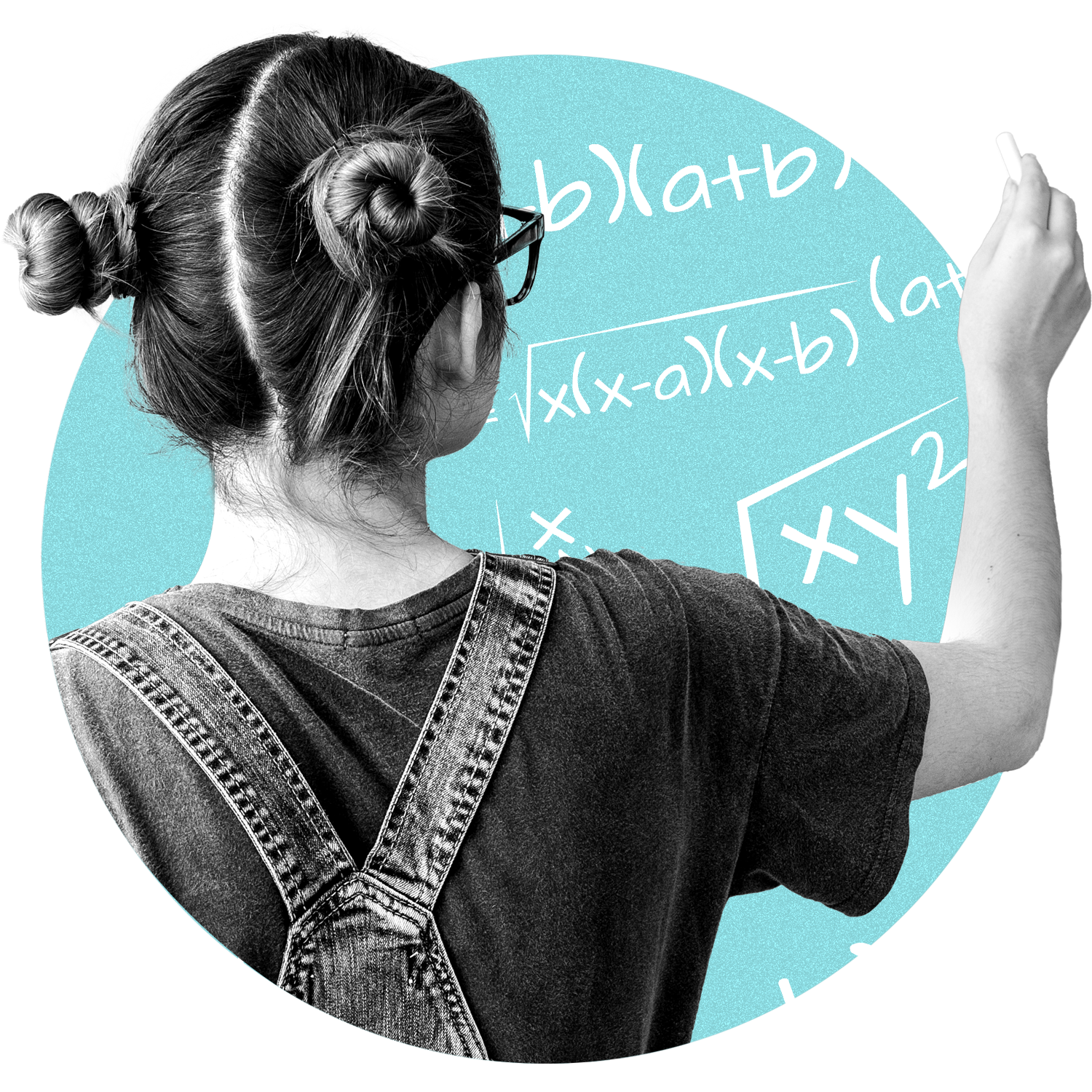
Sign up for our newsletter
Get the latest educator insights and practical classroom tips every other week, direct from the XQ community
Follow us to #RethinkHighSchool